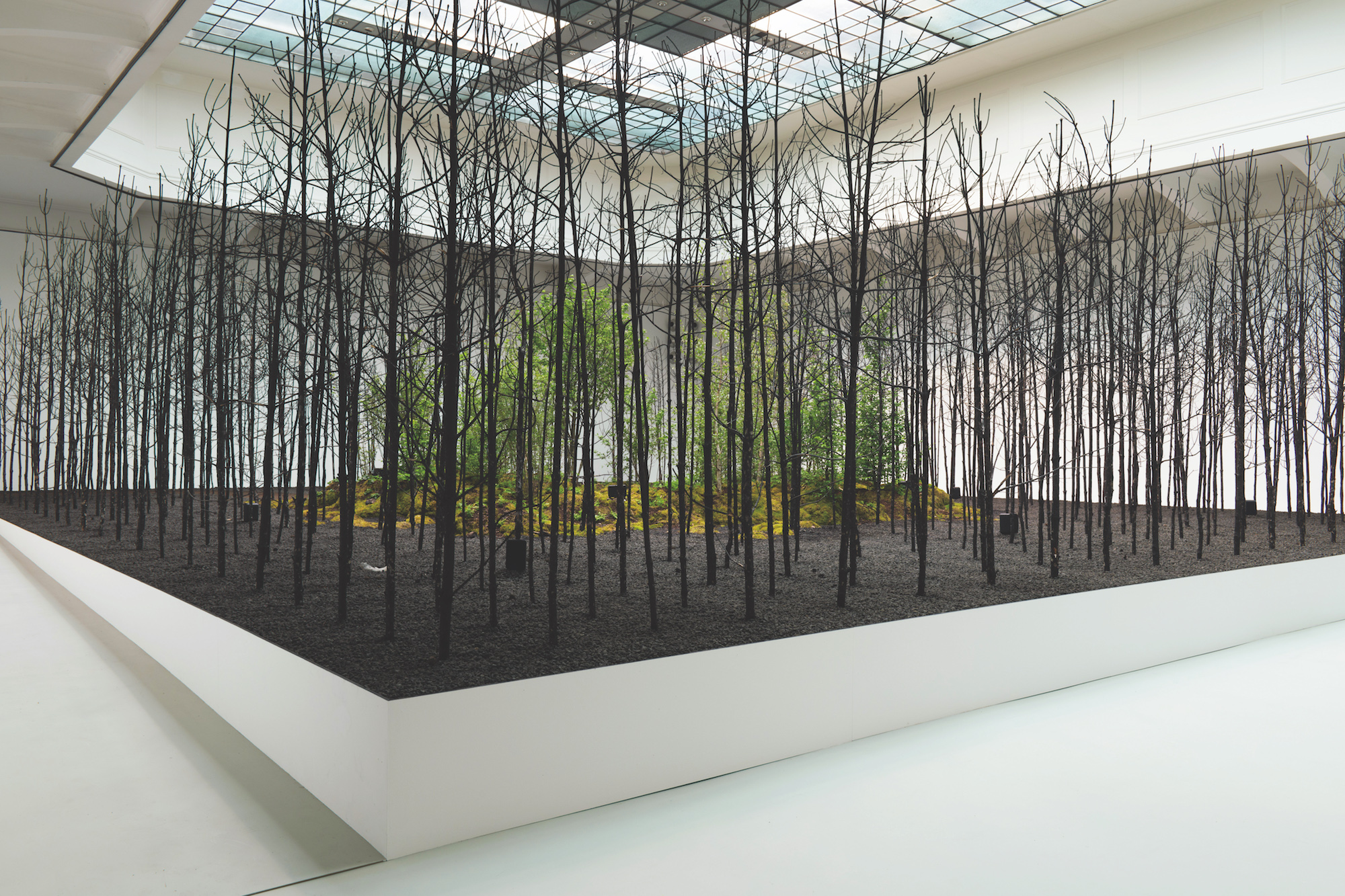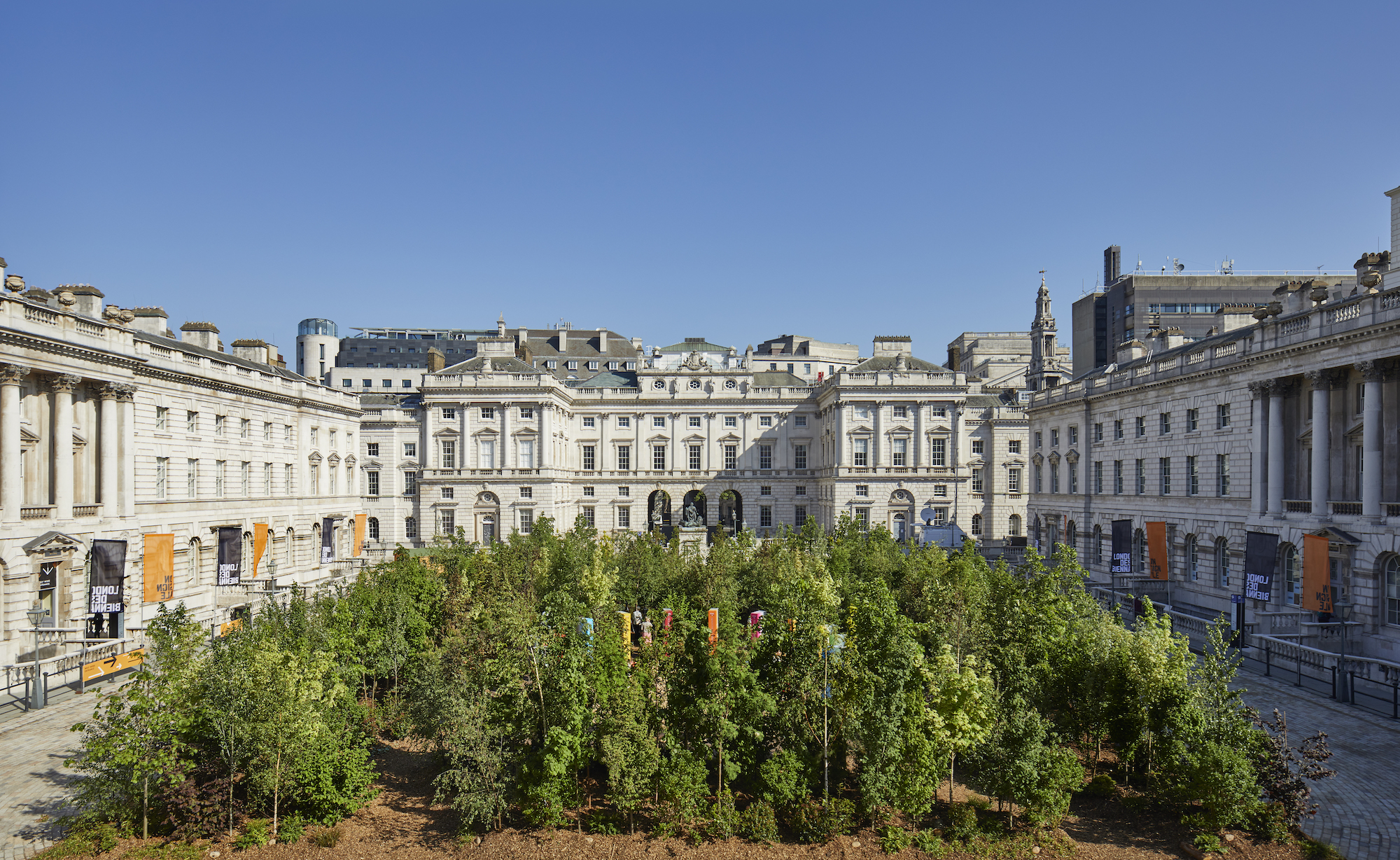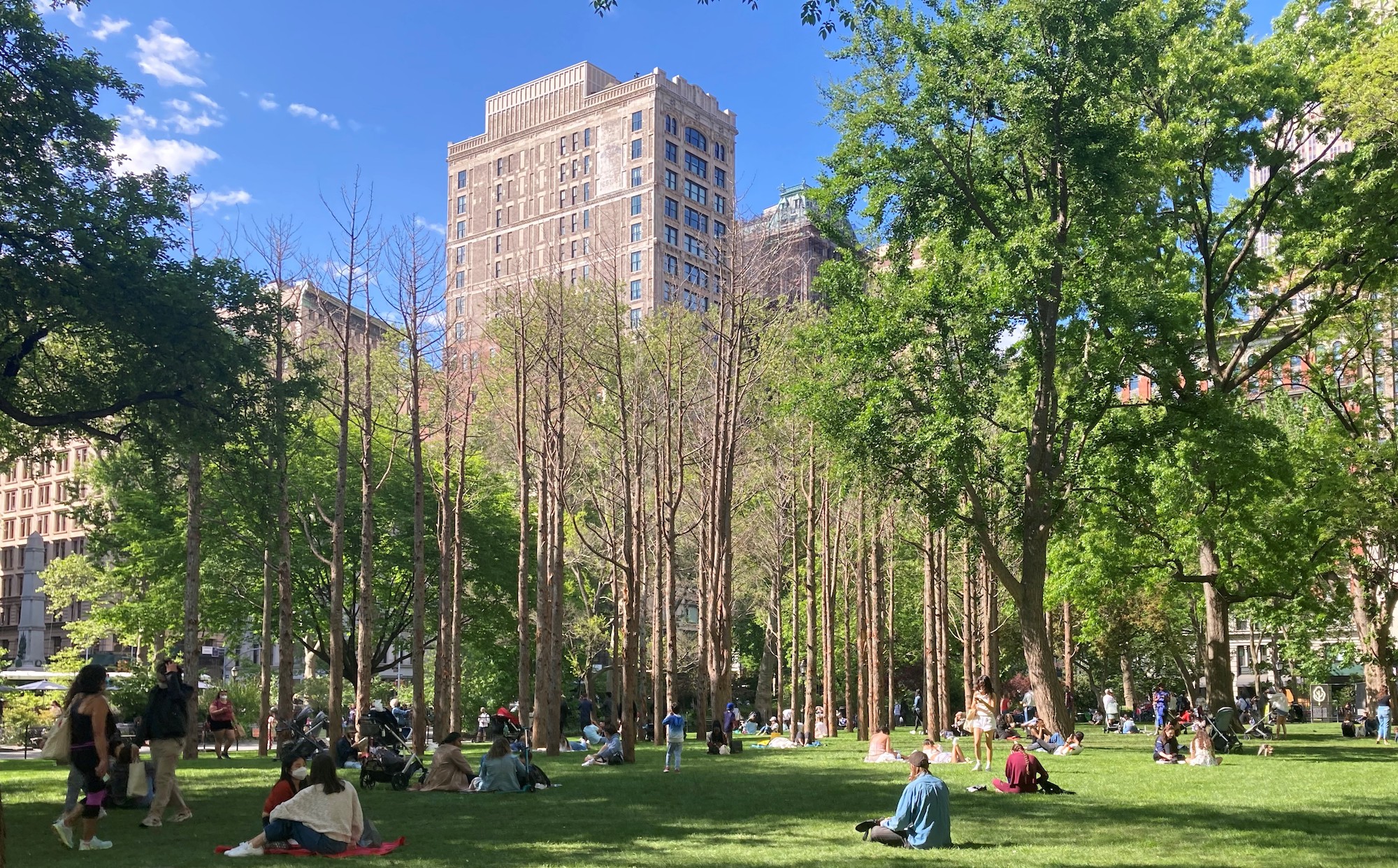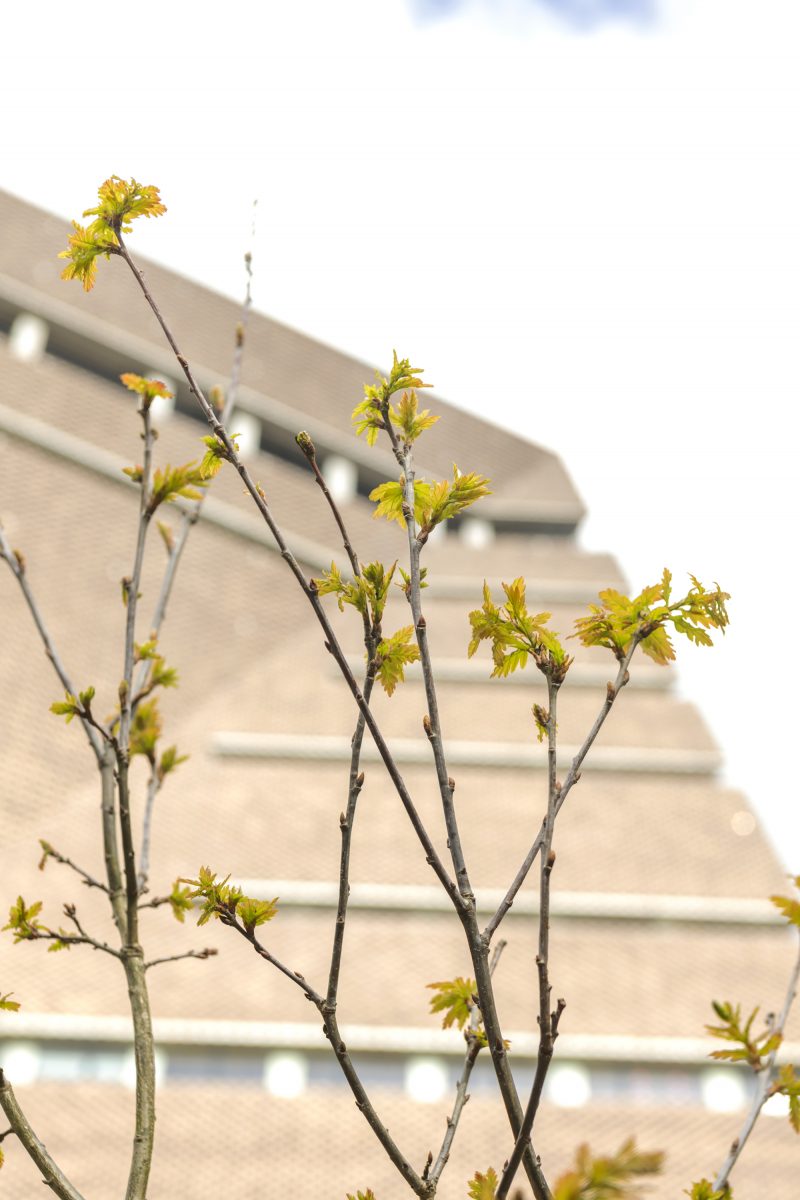
Picture a tree, majestic and tall, its leaves blowing gently in the wind. Trees have long symbolised ecological ‘greenness’, a reliable stand-in for the wild and varied expanse of nature in total. From stereotypes of tree-hugging hippies to brand-to-consumer promises that “we plant a tree for every purchase”, trees are at the heart of ecological imagery. As some of our most charismatic megaflora, they surely have a right to be.
Since at least the 1960s, trees have been appearing in large-scale installations of contemporary art. But when it comes to addressing the ongoing climate crisis, it’s worth investigating the ecological worth of these installations. While they might be hoping to reconnect us to the symbolic and biological richness of the natural world, are these exhibited trees, stripped from their own habitat, really having the impact that the artists and curators desired?
PR-darling Es Devlin’s recent installation Forest for Change, displayed at London’s Somerset House this June, transported a small patch of woodland into the courtyard of the historic venue. The claim was that “allowing a forest to overtake the entire courtyard” would counter enlightenment attitudes of human dominance over nature. Unfortunately, the plasticky ‘forest floor’ was barely a foot thick—hardly an appropriate planting depth for saplings—and the trees visibly wilted and browned in the bright courtyard. As for what happens to the trees after their appearance? The press release promised “more details soon”. Other sources claim they will be planted, or return to the nursery where they were grown—albeit presumably much the worse for wear and likely with shortened lifespans.

The installation asked us to contemplate 30 UN goals for sustainable development, goals most serious conservationists and climate scientists agree are barely meeting the absolute minimum requirements and display a morbid obsession with sustaining economic growth. Surely anyone who is already paying attention doesn’t need the evocative power of a so-called ‘forest’, featuring piped-in birdsong, to convince them that these goals and more are urgently necessary. Anyone unconvinced or unaware of what is at stake when it comes to the ecological health of our planet is hardly likely to be moved by a fast-wilting facsimile.
Another ‘forest’ that has appeared on the tent-up-touch-down international art circuit calendar in 2021 is speculative design studio Superflux’s Vienna Biennale project, titled Invocation of Hope. A vision of biodiversity rising again post-collapse, it aims to show us a better “post-anthropocentric” world in which we are at one with animals at a watering hole. The combination of regimented rows of trees burnt in Austrian wildfires and an organic, multispecies micro-forest is designed to inspire through juxtaposition. After the biennial the burnt trees will enrich compost, and the living ones will be donated to schools (to do what with is unclear).

Although much is made of the ecosystem-like nature of this installation, it strikes me as horticulturally implausible, and rings with artificiality, even to the most casual of observers. To merely represent a hopeful vision of the future, in which the trees that are so in need of protection are internationally transported, displayed and ultimately aestheticised, verges on the blinkered. There is no exploration here of how we move beyond the habits and behaviours embodied in these charred trunks—other than, apparently, an appeal to the transformative power of designed experiences.
More damaged trees make up another installation in Madison Square Park, New York, the brainchild of sculptor, architect and land artist Maya Lin. The 49 Atlantic white cedar trees in the Ghost Forest installation are dead, killed by salt-water infiltration in their once vibrant but incredibly vulnerable home ecosystem, the Pine Barrens of New Jersey. They were moved as part of a large conservation initiative and will rest in the park for a year, haunting Manhattanites’ experience of nature, and inviting contemplation of “nature based solutions” through the accompanying program.
“Whether these exhibited trees are alone a sufficient incitement to explore positive change is uncertain”
The work acknowledges the trees’ mortality and vulnerability even as it seeks to immortalise them as inspirational. But whether these exhibited trees are alone a sufficient incitement to explore positive change is uncertain. Their setting in a park rather than a gallery enables them to interact with a genuine ecological context. When the dead trees eventually rot, they will feed into that ecosystem as part of their afterlife as an installation, rather than being dragooned into service while they were still alive.
At the other end of the life-cycle spectrum is Ackroyd and Harvey’s Beuys’ Acorns, a project that started in 2007 and is spending this summer on the concourse outside Tate Modern. Grown from acorns collected from some of the 7,000 oak trees Beuys had planted in Kassel between 1982 and 1987, 100 saplings in planters encourage people to consider what has and hasn’t changed in the four decades years since the original mass tree planting. The trees are all young, and will be planted out when strong enough, provided a sojourn in central London isn’t detrimental to their health. Although it is unclear whether the exact species is native, oaks of all kinds are known to host the greatest volume of associated wildlife.
Beuys’ Acorns brings the question of tree-based installations full-circle, back to the blossoming of ecological consciousness. Its latest iteration is a continuation of a discussion and a project begun decades ago, a re-assessment of tree-planting as a practice that takes an embodied approach to questions of behaviour and history. It argues not just broadly that “trees hold the answer”, but more specifically (although perhaps more controversially) that Beuys’ project was conceived along lines that are still useful to us today. The question on the table is whether this is true.

“What these installations contain are zombies or waxworks, the dead and the display copy”
What differentiates Lin’s and Ackroyd and Harvey’s projects from Superflux and Devlin’s is the greater degree of reality their trees possess, as well as their integration into a wider ecosystem. All too often what are exhibited in many modern ‘eco’ installations are not, really, trees. A tree is so much more than a stick of cellulose and lignin. What these installations contain are zombies or waxworks, the dead and the display copy. They lack the ability to speak either to their manifest reality or their mythological depth, and require us to reach into our memories for associations, meaning, and the adrenaline rush of deep connection.
Inviting us to contemplate empty images of trees does not move us any closer to a spiritual or emotional (re-)engagement with post-growth living, plant magic, anti-extractive design, or anything else remotely useful. It is eco-communication at its most basic.
This alone isn’t enough. If the sublime horror of thousands and thousands of hectares of forest turning molten every year isn’t jerking anyone out of their stupor, I doubt a visit to a handful of depressed trees in a courtyard will do it. We are still cutting down ancient oaks to rebuild old cathedrals, and chopping redwoods up to help fund billionaires going to space. Saying “Behold! Trees!” is outdated and shortsighted. It’s time for real change.
Sukayna Powell is a London-based writer, editor, alternative education advocate and mushroom evangelist








